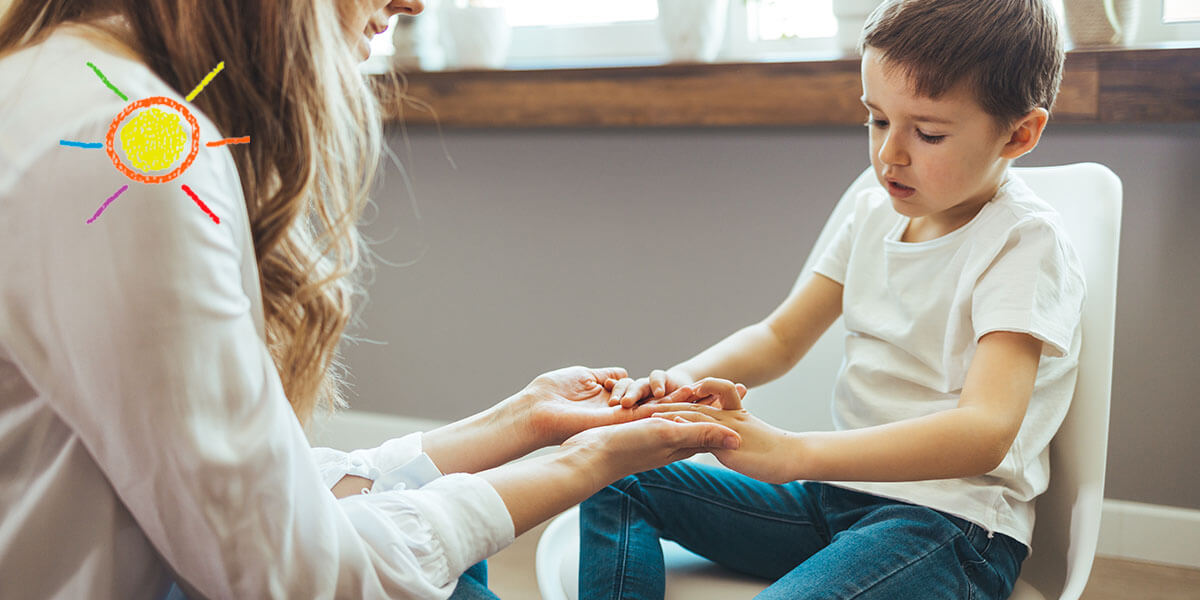Autism and anxiety can impact a child’s brain and behavior in similar ways — overstimulation, understimulation or uncertainty about their environment can lead to a breakdown of social skills as children struggle to maintain a sense of internal calm and control.
Teaching emotional regulation is one way to help children with autism or anxiety handle unexpected events and experience inner calm. External factors feel less threatening and disruptive when children can better manage their internal environment. Let’s review more about emotional regulation and ways to teach it to children who have anxiety and autism.
What Is Emotional Self-Regulation?
Emotional self-regulation is the skill of understanding and responding to emotions in a healthy way. People experience a wide range of emotions, and these emotions are connected to thoughts. While some emotions are a response to other people or external stimuli, other emotions arise from thoughts you have while alone.
Thoughts have a massive impact on human behavior. Many are positive and represent an accurate reflection of reality, but others do not. People who develop strong emotional intelligence have learned to think about their thoughts. They can recognize what emotions they experience, what ideas those emotions are connected to and whether they should believe those thoughts.
Emotional regulation can be taught and learned through practice. Most people subconsciously develop emotional regulation skills as children through interacting with the world around them. However, children with autism or high anxiety may face challenges when gathering accurate sensory data about their experiences. As they mature, being out of touch or misunderstood can make it difficult to learn emotional regulation.
Emotions always make themselves known eventually. Children with autism may demonstrate frustration, confusion, anger, fear or other strong emotions by physically acting out or withdrawing from those around them. Some children with autism struggle to identify certain emotions until their physical behavior demonstrates that something is wrong. For these kids, emotional regulation starts with understanding and identifying specific emotions.
Helping Children With Autism to Communicate
Every child who experiences autism or anxiety does so in an individual way — there is no one-size-fits-all diagnosis. In clinical terms, this means the best therapy choices for each child are unique. Learning about common forms of autism and what different responses may mean can help you listen and gather data for the child in your life.
Many behaviors typically associated with autism are a response to overstimulation. For example, repetitive physical behaviors like stimming and rocking can help children with autism express an internal stress response. However, some children with autism actually seek out intense stimulation as a way to calm themselves. Bright lights, loud noises and other sensory stimulation can feel calming to these children.
Some children with autism may verbally express their emotions or ask for help with managing strong feelings. However, many others struggle to understand, label and control the response to what they feel. Young children especially may benefit from learning about kinds of emotions, how to recognize them and what healthy steps they can take to resolve the intense feelings they experience.
Neurotypical children usually learn to self-regulate much younger than children with autism or high anxiety. Children with autism may struggle to handle uncertainty or changes to their plans. When their routine is disrupted, it can ruin their whole day. Emotional regulation skills help children with autism and anxiety learn to be more flexible and communicate more effectively with their own bodies and the external world.
3 Strategies for Teaching Emotional Self-Regulation
Children with autism and children with anxiety can be easily triggered throughout their day. Something that wouldn’t bother a neurotypical child — like a disruption in schedule, being in a crowd or hearing loud music — may cause a meltdown. Although avoiding these triggers can help keep children calm, it will not help them develop healthy processing skills. Here are three ways you can teach children emotional self-regulation skills:
1. Break It Down
As an adult, you’ve learned to process a large amount of external and internal data very quickly. When you were a child, many of these gross motor functions likely seemed difficult and even incomprehensible. One of the best ways you can support children with autism and anxiety is by breaking gross motor functions down into practical, manageable steps. This reduces stress and builds skills one step at a time.
Imagine you’re working with a child who gets very angry when it’s time to turn off her favorite TV show. You could play a TV show she doesn’t like as much, then reward her every time you turn it off and she responds well. This develops her cognitive muscles and teaches her to respond differently to a similar situation. Over time, you can reintroduce her favorite show and practice turning that one off, too.
2. Share Stories
Children around the world learn social skills from stories. Stories about emotions provide an opportunity to discuss what emotions are, what they feel like and how they can be triggered. They’re also a fantastic medium for exploring different choices for how to respond to emotions. Through stories, children can plan ahead and envision new possibilities.
You can teach through stories by reading books, playing with stuffed animals and watching TV or online videos. Choose a medium that the child enjoys — this will help them stay focused and absorb the information. The next time the child starts to act out, you can remind them of a story you’ve shared and what their favorite character did when they felt a strong emotion.
3. Practice Healthy Responses
Another way to teach emotional regulation is to compare good versus bad choices. Choose one emotion at a time to focus on. Talk about what that emotion feels like and what might cause people to feel that way. Then, give the child options for responding to that emotion in a healthy, acceptable way.
For example, some children bang their heads against the wall when they feel anxious. You can help them identify and address the emotion of anxiety before they reach that point. Instead of hurting themselves, have them practice deep breaths, exercising or listening to music. The best options will vary for each child, so don’t be afraid to experiment and find solutions together.
Develop Emotional Regulation Skills With MySpot Care
Do you or a family member struggle with emotional self-regulation? With the right support, this is a skill that can be developed and strengthened in adults, teenagers and children. Emotional regulation skills can significantly increase happiness and a sense of serenity in daily life. They positively impact relationships, learning opportunities and more.
At MySpot Care, board-certified and licensed behavior analysts can support you or your child’s journey to learn better emotional regulation. We use techniques and strategies that build a scaffolding you can rely on when faced with triggers. Contact us today to learn more and get started.


